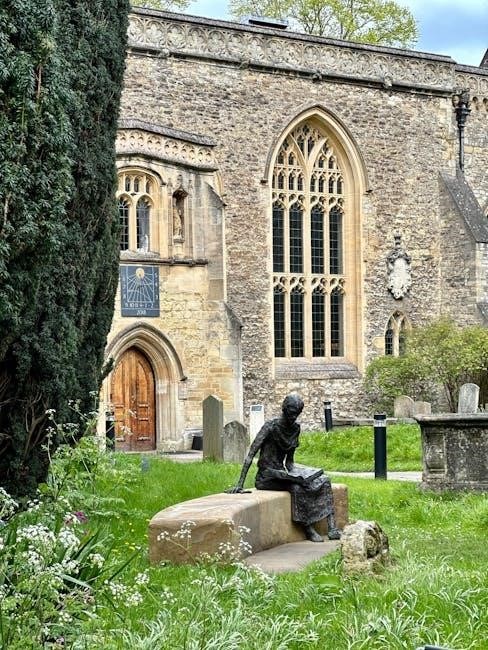Guide Me, O Thou Great Jehovah Hymn Overview
Written by William Williams in 1745, this hymn, translated by Peter Williams, is a powerful expression of trust in God’s guidance and provision, included in the Baptist Hymnal.
1.1 Historical Background and Significance
Written by William Williams in 1745, this hymn reflects the spiritual journey of believers seeking divine guidance. Originally penned in Welsh, it was later translated by Peter Williams, gaining widespread popularity. The hymn’s inclusion in the Baptist Hymnal highlights its enduring relevance, offering comfort and hope through its powerful imagery and heartfelt prayer. Its rich history and emotional depth have made it a cherished piece in Christian worship across generations. The hymn’s themes of trust in God’s guidance and provision resonate deeply, making it a timeless anthem of faith. Its global appeal has cemented its place as a foundational hymn in worship traditions worldwide.
1.2 Structure and Composition
The hymn is structured with two verses and a repeated chorus, creating a simple yet powerful framework for worship. The verses introduce themes of pilgrimage and spiritual renewal, with vivid imagery like the “crystal fountain” and “fiery, cloudy pillar,” symbolizing divine guidance and healing. The chorus, “Bread of heaven, feed me now and evermore,” emphasizes spiritual nourishment and eternal provision. This structure effectively builds a worship experience, moving from personal plea to communal affirmation. The composition’s accessibility and memorable melody enhance its congregational appeal, making it a timeless favorite for expressing trust in God’s guidance and provision. Its clear structure reinforces its theological themes and emotional depth.

Lyrics and Their Meaning
The hymn explores divine guidance and spiritual nourishment, with verses depicting pilgrimage and renewal, and a chorus emphasizing eternal provision through Christ, the Bread of Life.
2.1 Verse 1: The Pilgrim’s Journey
The first verse introduces the believer as a pilgrim in a barren land, symbolizing human weakness and the need for divine strength. The lines “I am weak, but Thou art mighty” express trust in Jehovah’s power, while “Hold me with Thy powerful hand” conveys a plea for guidance. The imagery of a desolate landscape evokes a sense of longing, emphasizing reliance on God’s strength. This verse sets the tone for the hymn, blending humility with faith, and transitions seamlessly into the chorus, which seeks spiritual nourishment and eternal provision. The theme of divine guidance resonates deeply, reflecting the believer’s journey through life’s challenges.
2.2 Verse 2: Spiritual Renewal

Verse 2 petitions for spiritual renewal, symbolized by the “crystal fountain” and “healing waters,” representing purification and restoration. The imagery of the “fiery, cloudy pillar” alludes to God’s guidance in Exodus, emphasizing His constant presence. The verse deepens the theme of trust, seeking both healing and divine leadership. The “healing stream” signifies spiritual restoration, while the pillar symbolizes protection and direction. This verse reflects a profound desire for spiritual nourishment and divine direction, resonating with believers’ longing for renewal. The chorus follows, reinforcing the need for eternal provision and sustenance, with Christ as the “Bread of Life,” fulfilling the soul’s deepest needs.
2.3 Chorus: Bread of Heaven
The chorus, “Bread of heaven, feed me now and evermore,” is a heartfelt plea for spiritual nourishment. The phrase “Bread of heaven” symbolizes Christ as the ultimate source of sustenance, drawing from John 6:35, where Jesus declares Himself the “Bread of Life.” The repetition of “feed me now and evermore” underscores a deep longing for eternal provision and spiritual growth. This refrain has become one of the hymn’s most memorable elements, resonating deeply in Christian worship. It emphasizes dependence on God and a desire for a relationship that transcends earthly needs, creating a powerful expression of faith and devotion.

Theological Themes
The hymn explores themes of divine guidance, spiritual trust, and eternal provision, emphasizing reliance on God’s strength and His faithfulness in times of weakness and uncertainty.
3.1 Divine Guidance and Trust
The hymn profoundly emphasizes divine guidance and trust, reflecting the believer’s reliance on God’s strength. The opening lines, “Guide me, O thou great Jehovah,” illustrate a deep dependence on divine leadership. The imagery of a pilgrim in a barren land underscores human vulnerability, while the plea, “I am weak, but thou art mighty,” highlights trust in God’s power. The reference to the pillar of cloud and fire from Exodus symbolizes God’s constant presence and guidance, offering comfort and assurance. This theme resonates throughout the hymn, encouraging believers to seek divine direction and trust in His faithfulness amidst life’s challenges and uncertainties.

3.2 Spiritual Nourishment and Eternal Provision
The hymn’s chorus, “Bread of heaven, feed me now and evermore,” underscores the theme of spiritual nourishment and eternal provision. This imagery, drawn from John 6:35, where Jesus is the Bread of Life, highlights the believer’s need for sustained spiritual sustenance. The repetition of “feed me” reflects a longing for divine provision and growth, illustrating faith’s requirement for ongoing nourishment. The hymn’s second verse petitions for spiritual renewal, symbolized by a crystal fountain and healing waters, emphasizing God’s abundant grace. The chorus becomes a heartfelt prayer, seeking eternal provision and a relationship with God that transcends earthly needs, resonating deeply with worshippers seeking spiritual refreshment and divine direction.

The Melody: Cwm Rhondda

The melody “Cwm Rhondda” was composed by John Hughes in 1905, originating from Wales. Its powerful, march-like quality perfectly complements the hymn’s themes, creating a timeless worship classic.
4.1 Composer and Background
John Hughes, a Welsh composer, created the melody Cwm Rhondda in 1905. Born in Dowlais, Glamorganshire, Hughes was deeply rooted in Welsh musical traditions. His composition was initially intended for a Baptist singing festival, where its powerful, march-like quality resonated immediately with the congregation. The melody’s emotive and uplifting nature made it an ideal accompaniment to William Williams’ hymn, Guide Me, O Thou Great Jehovah. Hughes’ work not only enriched Welsh hymnody but also became a global favorite, bridging cultural divides through its universal appeal. His legacy endures as Cwm Rhondda continues to inspire worship worldwide.
4.2 Congregational Appeal
The melody Cwm Rhondda has a rousing, march-like quality that enhances its congregational appeal. Its emotive harmony and stirring rhythm create a powerful, unifying experience for worshippers. The tune’s uplifting nature resonates deeply, fostering a sense of hope and triumph. Its adaptability allows it to complement the hymn’s themes of trust and divine guidance, making it a favorite in congregational singing. The melody’s ability to evoke strong emotions and unite voices has made it a staple in worship services worldwide. Its enduring popularity lies in its ability to inspire and connect believers across generations and cultures, ensuring its place in both traditional and contemporary worship settings.

Legacy and Contemporary Use

This hymn remains a timeless prayer, resonating across generations. Its rousing melody and universal themes make it a beloved worldwide worship anthem, adaptable to modern and traditional settings.
5.1 Enduring Popularity
Guide Me, O Thou Great Jehovah remains a timeless and cherished hymn, resonating deeply across generations. Its powerful lyrics and rousing melody, set to Cwm Rhondda, create a profound emotional connection. The hymn’s themes of trust, divine guidance, and spiritual nourishment continue to inspire worshippers globally. Its adaptability to both traditional and contemporary worship settings has ensured its relevance. Featured in numerous hymnals, including the Baptist Hymnal, it is often performed at significant events, such as Prince Harry and Meghan Markle’s wedding. Its enduring appeal lies in its ability to transcend cultural and generational boundaries, offering comfort, hope, and a sense of unity to all who sing it. Its influence on modern worship music further solidifies its lasting legacy.
5.2 Influence on Modern Worship

Guide Me, O Thou Great Jehovah has significantly influenced modern worship, blending traditional and contemporary styles. Its rousing melody, Cwm Rhondda, has inspired modern composers to create uplifting worship songs. The hymn’s themes of trust and divine guidance resonate in today’s music, making it a bridge between classic and modern worship. Its adaptability allows it to be used in various settings, from traditional services to contemporary gatherings. This timeless hymn continues to inspire new generations, ensuring its influence remains strong in both traditional and modern worship contexts, offering a profound connection to faith and devotion across different musical styles and cultural backgrounds. Its legacy endures as a cherished anthem of faith.
